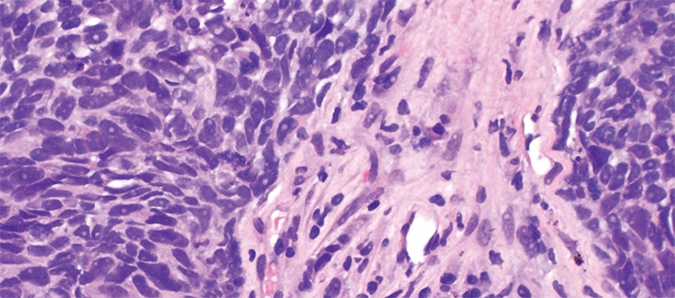JBC: A promiscuous inhibitor uncovers cancer drug targets
When signaling pathways within cells are triggered, proteins activate like a row of tumbling dominoes until the final protein influences some cellular function. In some tumors, multiple signaling pathways drive cell growth and survival; if one pathway ceases activity, another could continue driving cancerous behavior.
Several clinically approved kinase inhibitors originally were designed to block the function of individual signaling kinase proteins. Scientists now know that some of these inhibitors indiscriminately disrupt numerous proteins, which may allow them to kill certain tumors but also may inhibit some proteins unnecessarily, eliciting adverse effects.
To pinpoint the most therapeutically relevant kinase targets in cancer cells, a group of researchers at Harvard Medical School and the Dana Farber Cancer Institute in Boston, led by , has developed a method that exploits the multitargeted nature of a chemical inhibitor.
In published in the Journal of Biological Chemistry, Gray and colleagues identified key molecules that support the survival of a specific type of lung cancer. By analyzing how these cells respond to a cancer-killing kinase inhibitor with numerous targets, they showed that the anti-cancer effects likely were elicited by simultaneous inhibition of two signaling pathways. This approach could lead to development of cancer drugs that attack only the right targets.
 A micrograph of a non–small cell lung carcinoma shows nuclei in purple and cytoplasm in pink.Librepath/Wikimedia CommonsWhile studying various kinase inhibitors, Gray and his lab identified one, known as SM1-71, which binds to dozens of kinases, some of which support cell survival and growth.
A micrograph of a non–small cell lung carcinoma shows nuclei in purple and cytoplasm in pink.Librepath/Wikimedia CommonsWhile studying various kinase inhibitors, Gray and his lab identified one, known as SM1-71, which binds to dozens of kinases, some of which support cell survival and growth.
“It was sort of like a stick of dynamite and really could hit a lot of different targets,” Gray said.
In the JBC study, the researchers exposed several cancer cell types to SM1-71 and found that the drug was highly toxic to a lung cancer cell line with a mutation that activates many signaling pathways that drive cell growth. The inhibitor’s ability to kill these mutated cells suggested that targets in several pathways were being hit, Gray said.
To discover which of the many buttons pushed by SM1-71 elicited its anti-cancer effects, the researchers used Western blotting to narrow down which signaling proteins related to survival and growth were being blocked in cancer cells, revealing that proteins in two critical pathways were inhibited.
The authors then applied various kinase inhibitors to see if inhibiting any combination of the proteins in these pathways would replicate the cancer-killing effects of SM1-71. In the end, inhibiting MEK1/2 and IGF1R/INSR proteins at the same time demonstrated similar effects, suggesting that these are crucial targets in this lung cancer line, Gray said.
SM1-71 is likely not viable in humans because it binds to too many proteins and could cause collateral damage, Gray said. But uncovering its most important targets within specific pathways is valuable for designing drugs that can shut down multiple signaling pathways, which is necessary in some tumors.
“The next step would be to try to preserve the efficacy-driving targets while getting rid of targets that may be contributing to the toxicology,” Gray said.
Enjoy reading 91��ɫ��ý Today?
Become a member to receive the print edition four times a year and the digital edition monthly.
Learn moreGet the latest from 91��ɫ��ý Today
Enter your email address, and we’ll send you a weekly email with recent articles, interviews and more.
Latest in Science
Science highlights or most popular articles

How HCMV hijacks host cells — and beyond
Ileana Cristea, an 91��ɫ��ý Breakthroughs webinar speaker, presented her research on how viruses reprogram cell structure and metabolism to enhance infection and how these mechanisms might link viral infections to cancer and other diseases.

Understanding the lipid link to gene expression in the nucleus
Ray Blind, an 91��ɫ��ý Breakthroughs speaker, presented his research on how lipids and sugars in the cell nucleus are involved in signaling and gene expression and how these pathways could be targeted to identify therapeutics for diseases like cancer.

Receptor antagonist reduces age-related bone loss in mice
Receptor antagonist reduces bone loss and promotes osteoblast activity in aging mice, highlighting its potential to treat osteoporosis. Read more about this recent JBC paper.

Engineered fusion protein targets kiwifruit pathogen
Synthetic protein selectively kills kiwifruit pathogen, offering a promising biocontrol strategy for agriculture. Read more about this recent JBC paper.

Pathogen-derived enzyme engineered for antibiotic design
Engineered variants of a bacterial enzyme developed at the University at Buffalo accept larger substrates, paving the way for new acinetobactin-based antimicrobials. Read more about this recent JBC paper.

Omega-3 fats linked to healthy aging and improved heart metabolism
Scientists from the University of Iowa find that a diet high in polyunsaturated fatty acids from fish oil increases cardiac triglyceride uptake and improves insulin sensitivity. Read more about this recent JLR study.

